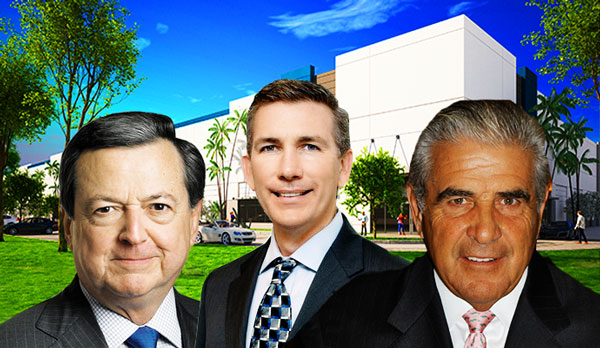Trending
Raising the roof: Will demand push industrial development to new heights?
Industry players expect development to go vertical

As anyone in commercial real estate knows, industrial space is one of the strongest sectors thanks to e-commerce. But in a raw-space-starved region like South Florida, those looking to put more inventory on the market are expanding northward to Broward in addition to exploring new ideas to meet high demand, like going vertical. And with fierce competition for space, commercial brokers are urging tenants to sign long-term industrial leases.
One model for South Florida’s double-decker industrial future can be found in Shanghai, China, which, with a similar scarcity of open space, has seen a number of multistory warehouses, Devin White, principal at CBRE, said.
“Extremely densely populated urban cores will see multistory warehouses sooner than later due to rapidly increasing land values,” White said. The lack of land Miami-Dade is putting an upward pressure on rents, White said. He predicts rents will increase by 3 percent to 5 percent in the next year.
“One option would be redevelopment vertically,” White said. “If there’s only about 40 million square feet of inventory left [in Miami-Dade], and you’re absorbing 2 [million] to 3 million square feet a year, that only gives you about 10 years remaining.”
In April, industrial giant Prologis broke ground on the nation’s first multistory warehouse in Seattle. The three-story, 590,000-square-foot project is building ramps to give trucks access to second-floor loading docks.
Though South Florida has yet to see its own multistory warehouse, developer Armando Codina said it may become necessary.
“I believe it is inevitable that sometime in the future – due to the lack of available industrial land in Miami – Miami will see multistory warehouses,” Codina, of Codina Partners, said. But the current condition of the industrial market, Codina said, does not justify multistory warehouses at the moment.
“Compared to years past, we have been consistently building taller and taller warehouses to keep up with tenant demands,” Codina, said. “Not only are the tenants and racking systems becoming more sophisticated in their use of the height, but in a tight market, this extra height is seen as on-demand expansion within a user’s space.”
Projects he completed in the late ’90s, like Beacon Centre near the airport, were among the first to feature 24-foot tall heights in the Doral area, Codina said. His latest Beacon Logistics project, planned on 55 acres of land in Hialeah, will feature 32-foot clear heights.
A competitive market
There’s an increasing demand for warehouse space particularly near Miami’s airport and in Medley and Hialeah.
As of the third quarter of last year a total of 2,234,405 square feet of industrial space was absorbed in Miami-Dade County, 59 percent of which was in the Airport/Doral submarket, according to a CBRE report. The Medley submarket absorbed 27 percent of that.
All that demand has created competition among tenants, Ed Easton, of the Doral-based commercial real estate company Easton Group, said. In his experience, tenants are becoming cautious of the state of the market and rising rent costs.
Even with prices at their peak, now is the time to rent, he said. “The market is as solid as a bullet.”
Over the summer, the Easton Group closed on a 180,000-square-foot industrial building in Medley and rented it within three months to a window manufacturing company that currently fully occupies the space. In another example, Easton said he represented a logistics company that lost three buildings in Doral it had placed bids on. The bids were north of $110 per square foot, Easton said. Two logistic companies and one manufacturing company won them, according to Easton.
“We can’t get buildings anywhere near $120 per square foot right now,” Easton said about the Doral area.
In addition, he’s advising his clients to sign longer term leases because he expects demand for industrial space to outweigh supply and push rents upward.
“It’s clear the demand for industrial is about 2 to 5 million square feet a year… I just don’t see how you’re going to create that kind of supply, economically,” Easton said.
Miami-Dade County exceeds Broward and Palm Beach counties in terms of new industrial inventory being built. Colliers International estimates about 3 million square feet of new inventory is under construction in Miami-Dade County, 1.6 million square feet in Broward County and almost 250,000 square feet in Palm Beach County.
A shift to Broward
This year a spotlight was placed on Broward, where – unlike Miami-Dade County – the average vacancy rate fell from 5.5 percent to 4 percent – marking its lowest point in a 10-year period when it was at 4.9 percent, according to a third quarter Cushman and Wakefield report.
“At this point we’re surpassing 2006 tremendously, which was a busy market. Absorption was huge at that time, [and] a lot of the absorption was home-related,” Chris Metzger, an executive at brokerage firm Cushman & Wakefield, who serves as the executive director of its South Florida industrial team, said. Furniture companies have taken the bulk of the inventory.
“What was interesting in 2006, when it was hot in Broward County, at the end of the year the vacancy rate was at 3.6 percent. At the end of the third quarter of 2009 the vacancy rate was 10.2 percent,” Metzger said, pointing to a return to 2006 figures.
Several big industrial projects are being built in Pompano Beach.
One of the largest includes Bridge Point Powerline Road, a nearly 468,000-square-foot industrial park being developed by Chicago-based Bridge Development Partners. Another notable development is the Pompano Center of Commerce, a 380,000-square-foot multi-phased project, developed by Prologis.
“There is still plenty of room left in this development cycle, especially in well positioned, underserved markets such as Pompano Beach,” Kevin Carroll, a principal of Bridge Development Partners and Florida market leader, said, adding Pompano Beach’s location, near major trade hubs like Fort Lauderdale-Hollywood International Airport, Port Everglades, Miami International Airport and PortMiami, attracts distribution and manufacturing companies.
A different tenant pool
Carroll and other industry leaders agree that South Florida’s industrial market has lured larger, international distribution, logistics and manufacturing brands compared to years before.
That’s because “tenants want to be close to their customers,” Carroll said.
The makeup of the tenant pool is changing, Metzger said. “It used to be [companies] looking for 20,000 square feet to 30,000 square feet. Now its 100,000 square feet to 200,000 square feet,” Metzger said.
Last summer, Orlando-based developer Foundry Commercial signed Amazon for an 800,000-square-foot lease at the Carrie Meek International Business Park in Opa-Locka, marking the e-commerce behemoth’s largest warehouse in Miami-Dade County.
Codina, who entered the bid for Amazon’s second headquarters in September, said future industrial parks being built to accommodate larger companies like Amazon will include truck courts, taller ceiling heights and more security.
“Large industrial parks allow tenants to be situated near similar businesses,” which can lower costs, Codina said. “Miami as a city is growing and the industrial market that supplies this population growth will grow in parallel.”




